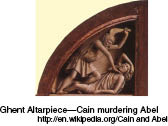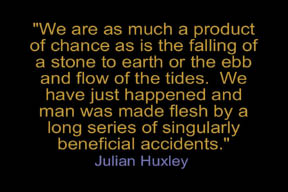Lesson 10
THE
HISTORY OF MAN?
 In our previous lessons, we saw that it is not possible
to determine the exact time that the creation occurred or the exact
time when man was placed on this planet. It is possible to reconstruct
a history of man from a scientific perspective that is compatible with
the biblical account. Because the scientific evidence changes daily,
one has to do this in a general way, but it can be done. Our purpose in
this exercise is to attempt to impress the student with the degree of
agreement that does exist in spite of the incompleteness of the record,
both scientifically and biblically.
In our previous lessons, we saw that it is not possible
to determine the exact time that the creation occurred or the exact
time when man was placed on this planet. It is possible to reconstruct
a history of man from a scientific perspective that is compatible with
the biblical account. Because the scientific evidence changes daily,
one has to do this in a general way, but it can be done. Our purpose in
this exercise is to attempt to impress the student with the degree of
agreement that does exist in spite of the incompleteness of the record,
both scientifically and biblically.
 The name Adam means man. The name Eve means the mother of
all living. Even to a casual observer of science it is obvious that all
humans on this planet came from a recent common ancestor. Man is a
singular species. There are not different species of man on the earth
who are incapable of producing fertile offspring with one another. A
blonde Swede can produce fertile offspring when married to an
aborigine, even though their physical appearances are quite different.
This oneness of man is quite different from the various monkeys and
apes who have become so varied in their genetic material that they no
longer can produce fertile offspring. Most monkeys vary from one
another by about 5 percent genetically while man varies less than .1
percent. Recent genetic studies have supported the idea of a single
female ancestor for all humans on
The name Adam means man. The name Eve means the mother of
all living. Even to a casual observer of science it is obvious that all
humans on this planet came from a recent common ancestor. Man is a
singular species. There are not different species of man on the earth
who are incapable of producing fertile offspring with one another. A
blonde Swede can produce fertile offspring when married to an
aborigine, even though their physical appearances are quite different.
This oneness of man is quite different from the various monkeys and
apes who have become so varied in their genetic material that they no
longer can produce fertile offspring. Most monkeys vary from one
another by about 5 percent genetically while man varies less than .1
percent. Recent genetic studies have supported the idea of a single
female ancestor for all humans on  the earth.
the earth.
We start out then with the realization that, as the Bible says, we all
came from a single human source. The spiritual nature of man was
present in this ancestor of ours. From a biblical standpoint, God had
created man in His image and man was unique. What man’s physical body
looked like is not explained to us in the Bible. Anthropologists like
to argue and conjecture on what early man really looked like. Artists,
because of the lack of information, have a field day with imaginative
sketches of what the mysterious ancestor looked like. The odds are that
they were small in stature, had dark skin, black eyes and hair, and did
not look much different from people in Iraq today. They possessed all
of the genetic information  needed to produce every physical
characteristic seen in the world’s people today.
needed to produce every physical
characteristic seen in the world’s people today.
 The Bible tells us God put
man in a place called the Garden of Eden. According to Genesis 2 (KJV)
this area was bounded by the Pison, Gihon, Hiddehel (Tigris), and
Euphrates rivers. Today those rivers are visible in the modern nation
of Iraq. This area is also known as the “fertile crescent” and is
sometimes called “the birthplace of civilization.” Africa is frequently
quoted as the cradle of man, but remember that most of the specimens
found in Africa are Australopithecines
and not humans. Some will argue for ancient hominoids in Africa, and
certainly the discussion remains open. There will never be a bone found
with a label that says, “This is the oldest man that will ever be
found,” so this question will always be open scientifically.
The Bible tells us God put
man in a place called the Garden of Eden. According to Genesis 2 (KJV)
this area was bounded by the Pison, Gihon, Hiddehel (Tigris), and
Euphrates rivers. Today those rivers are visible in the modern nation
of Iraq. This area is also known as the “fertile crescent” and is
sometimes called “the birthplace of civilization.” Africa is frequently
quoted as the cradle of man, but remember that most of the specimens
found in Africa are Australopithecines
and not humans. Some will argue for ancient hominoids in Africa, and
certainly the discussion remains open. There will never be a bone found
with a label that says, “This is the oldest man that will ever be
found,” so this question will always be open scientifically.
What was the nature of these first humans? Genesis tells us that they
ate from the trees and bushes in the Garden. They were
gatherers--picking their food from the abundance of the land in which
they lived. Most scientists agree that this method of obtaining food
was the dominant method of early man. When man was removed from the
Garden he no longer was in a utopian environment. While anthropologists
do not concern themselves with the role of sin and why man was no
longer in Paradise, they do recognize that conditions changed upon the
earth. No longer could man survive by gathering. In recognition of that
fact man was consigned to eat by the “sweat of [his] brow.” The Bible
does not describe the various ways that man ate after his removal from
the garden, but we do know that Cain was a grower and domesticator of
plants, Abel had domesticated animals, and later Esau was a hunter. At
least these three methods were used.
 From a scientific standpoint
the evidence is somewhat blurred. Piles of oyster shells are found with
the remains of humans in caves all over the world. Evidence of very
early hunting is found in many places. Incredibly complex agriculture
has been found in different areas of the world. It is important to
realize that the accomplishments of our ancestors were remarkable.
Ancient man was very intelligent! He was ignor
From a scientific standpoint
the evidence is somewhat blurred. Piles of oyster shells are found with
the remains of humans in caves all over the world. Evidence of very
early hunting is found in many places. Incredibly complex agriculture
has been found in different areas of the world. It is important to
realize that the accomplishments of our ancestors were remarkable.
Ancient man was very intelligent! He was ignor ant and had much to learn, but he did incredible things.
His art work inspires us today with the skill and technical knowledge
he possessed, and the edifices and structures which have endured to our
time are frequently incredibly complex.
ant and had much to learn, but he did incredible things.
His art work inspires us today with the skill and technical knowledge
he possessed, and the edifices and structures which have endured to our
time are frequently incredibly complex.
The great weakness of man during his early history was very much like
his weakness today--a terrible tendency to live selfishly and
violently. The Bible tells us that man’s drift away from God was so
rapid and so total that catastrophe resulted over and over again. In
the biblical record we read of disobedience, sexual promiscuity,
drunkenness, rape, homosexuality, substance abuse, family turmoil, and
war. From a historical, archaeological, and scientific standpoint this
history is incontrovertible. Not only can we verify man’s horrendous
moral compromises, but also the catastrophic result of these acts.
Syphilis of ancient days and AIDS of our day speak eloquently of the
consequences that man reaps when he compromises himself and refuses to
follow the moral standards given him by God.
We have emphasized in this brief summary the positive correlations
between the biblical history of man and the records of science and
history. What about the conflicts? The conflicts are few and far
between as long as we stick to the facts. Attempting to put a date on
man biblically produces a man-made conflict which need not exist since
the Bible is silent on the age of the earth. Another conflict is
generated when atheists and skeptics attempt to define man as no more
than an animal. A good example of this is Julian Huxley’s statement
below (The Human Degree, [J.B.
Lippincott Co., 1976]).
This perspective is in opposition to the biblical record, but it is a
personal philosophical viewpoint and has no scientific support as we
have seen. Accepting such a view of man relegates man to biological
determinism and denies man’s spiritual or moral qualities. The efforts
of scientists to trace the physical changes that have taken place in
the human species is also not a threat to the Bible since this kind of
change is unrelated to the Bible’s purpose.
If the Bible was inspired by the same God who did the creating, it is
impossible for there to be a contradiction between the biblical record
and the fossil record. The evidence available to man today strongly
supports this agreement. If there is an apparent conflict, there are
three sources of error--bad science, bad theology, or both. It is our
contention that there has been a lot of both.
 Once man reached a certain level of cultural development,
rapid change took place. The Bible gives only a thumbnail sketch of the
things that happened. There is no way of knowing how long Adam and Eve
were in the Garden of Eden. It is possible, or perhaps even likely,
that they had many children and grandchildren during that time. God had
told them to be fruitful and multiply (the one command of God that man
seems to have obeyed) and Eve was told, “I will greatly increase your
pains in childbearing” indicating she had already borne children. Cain
married someone and worried about others killing him.
Once man reached a certain level of cultural development,
rapid change took place. The Bible gives only a thumbnail sketch of the
things that happened. There is no way of knowing how long Adam and Eve
were in the Garden of Eden. It is possible, or perhaps even likely,
that they had many children and grandchildren during that time. God had
told them to be fruitful and multiply (the one command of God that man
seems to have obeyed) and Eve was told, “I will greatly increase your
pains in childbearing” indicating she had already borne children. Cain
married someone and worried about others killing him.
Once man left the Garden his gathering life style had to change. This
meant the development of new tools and weapons. Man migrated throughout
the earth, and while we have no provable dates for the antiquity of
this activity, it seems to have been a long time ago. It is not until
well into man’s spread through the world that written records of any
kind began to appear. The intelligence and ingenuity of ancient man is
remarkable when you realize the limited communication and education
tools that were available at the time.
The Bible is a great source of ancient history. When artifacts which
recorded history and various kinds of written materials could be
produced, a checkable history could be studied. Modern archaeologists
continue to find support for the biblical record and the unique
development of modern man. One fact that appears in all of these
records is the fact that man has consistently failed to live
successfully on the earth. Mankind has been irresponsible in management
of the earth, and reckless and inhumane in the treatment of one another.
In our next lesson, we want to look at man’s needs and how those needs
can be and should be met. Does the Bible make any sense at all in its
plan for successful living, or is Christianity just a way of
legislating morality to please the whims of a chosen few?
© 2009, John N. Clayton
Lesson 10 Questions
Return to the Main
Page
for the
Intermediate Correspondence Course.
11/9/2009

 In our previous lessons, we saw that it is not possible
to determine the exact time that the creation occurred or the exact
time when man was placed on this planet. It is possible to reconstruct
a history of man from a scientific perspective that is compatible with
the biblical account. Because the scientific evidence changes daily,
one has to do this in a general way, but it can be done. Our purpose in
this exercise is to attempt to impress the student with the degree of
agreement that does exist in spite of the incompleteness of the record,
both scientifically and biblically.
In our previous lessons, we saw that it is not possible
to determine the exact time that the creation occurred or the exact
time when man was placed on this planet. It is possible to reconstruct
a history of man from a scientific perspective that is compatible with
the biblical account. Because the scientific evidence changes daily,
one has to do this in a general way, but it can be done. Our purpose in
this exercise is to attempt to impress the student with the degree of
agreement that does exist in spite of the incompleteness of the record,
both scientifically and biblically. The name Adam means man. The name Eve means the mother of
all living. Even to a casual observer of science it is obvious that all
humans on this planet came from a recent common ancestor. Man is a
singular species. There are not different species of man on the earth
who are incapable of producing fertile offspring with one another. A
blonde Swede can produce fertile offspring when married to an
aborigine, even though their physical appearances are quite different.
This oneness of man is quite different from the various monkeys and
apes who have become so varied in their genetic material that they no
longer can produce fertile offspring. Most monkeys vary from one
another by about 5 percent genetically while man varies less than .1
percent. Recent genetic studies have supported the idea of a single
female ancestor for all humans on
The name Adam means man. The name Eve means the mother of
all living. Even to a casual observer of science it is obvious that all
humans on this planet came from a recent common ancestor. Man is a
singular species. There are not different species of man on the earth
who are incapable of producing fertile offspring with one another. A
blonde Swede can produce fertile offspring when married to an
aborigine, even though their physical appearances are quite different.
This oneness of man is quite different from the various monkeys and
apes who have become so varied in their genetic material that they no
longer can produce fertile offspring. Most monkeys vary from one
another by about 5 percent genetically while man varies less than .1
percent. Recent genetic studies have supported the idea of a single
female ancestor for all humans on  the earth.
the earth. needed to produce every physical
characteristic seen in the world’s people today.
needed to produce every physical
characteristic seen in the world’s people today. The Bible tells us God put
man in a place called the Garden of Eden. According to Genesis 2 (KJV)
this area was bounded by the Pison, Gihon, Hiddehel (Tigris), and
Euphrates rivers. Today those rivers are visible in the modern nation
of Iraq. This area is also known as the “fertile crescent” and is
sometimes called “the birthplace of civilization.” Africa is frequently
quoted as the cradle of man, but remember that most of the specimens
found in Africa are Australopithecines
and not humans. Some will argue for ancient hominoids in Africa, and
certainly the discussion remains open. There will never be a bone found
with a label that says, “This is the oldest man that will ever be
found,” so this question will always be open scientifically.
The Bible tells us God put
man in a place called the Garden of Eden. According to Genesis 2 (KJV)
this area was bounded by the Pison, Gihon, Hiddehel (Tigris), and
Euphrates rivers. Today those rivers are visible in the modern nation
of Iraq. This area is also known as the “fertile crescent” and is
sometimes called “the birthplace of civilization.” Africa is frequently
quoted as the cradle of man, but remember that most of the specimens
found in Africa are Australopithecines
and not humans. Some will argue for ancient hominoids in Africa, and
certainly the discussion remains open. There will never be a bone found
with a label that says, “This is the oldest man that will ever be
found,” so this question will always be open scientifically.
 From a scientific standpoint
the evidence is somewhat blurred. Piles of oyster shells are found with
the remains of humans in caves all over the world. Evidence of very
early hunting is found in many places. Incredibly complex agriculture
has been found in different areas of the world. It is important to
realize that the accomplishments of our ancestors were remarkable.
Ancient man was very intelligent! He was ignor
From a scientific standpoint
the evidence is somewhat blurred. Piles of oyster shells are found with
the remains of humans in caves all over the world. Evidence of very
early hunting is found in many places. Incredibly complex agriculture
has been found in different areas of the world. It is important to
realize that the accomplishments of our ancestors were remarkable.
Ancient man was very intelligent! He was ignor ant and had much to learn, but he did incredible things.
His art work inspires us today with the skill and technical knowledge
he possessed, and the edifices and structures which have endured to our
time are frequently incredibly complex.
ant and had much to learn, but he did incredible things.
His art work inspires us today with the skill and technical knowledge
he possessed, and the edifices and structures which have endured to our
time are frequently incredibly complex.

 Once man reached a certain level of cultural development,
rapid change took place. The Bible gives only a thumbnail sketch of the
things that happened. There is no way of knowing how long Adam and Eve
were in the Garden of Eden. It is possible, or perhaps even likely,
that they had many children and grandchildren during that time. God had
told them to be fruitful and multiply (the one command of God that man
seems to have obeyed) and Eve was told, “I will greatly increase your
pains in childbearing” indicating she had already borne children. Cain
married someone and worried about others killing him.
Once man reached a certain level of cultural development,
rapid change took place. The Bible gives only a thumbnail sketch of the
things that happened. There is no way of knowing how long Adam and Eve
were in the Garden of Eden. It is possible, or perhaps even likely,
that they had many children and grandchildren during that time. God had
told them to be fruitful and multiply (the one command of God that man
seems to have obeyed) and Eve was told, “I will greatly increase your
pains in childbearing” indicating she had already borne children. Cain
married someone and worried about others killing him.